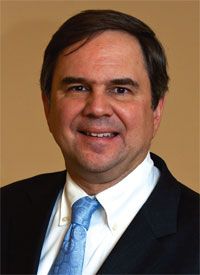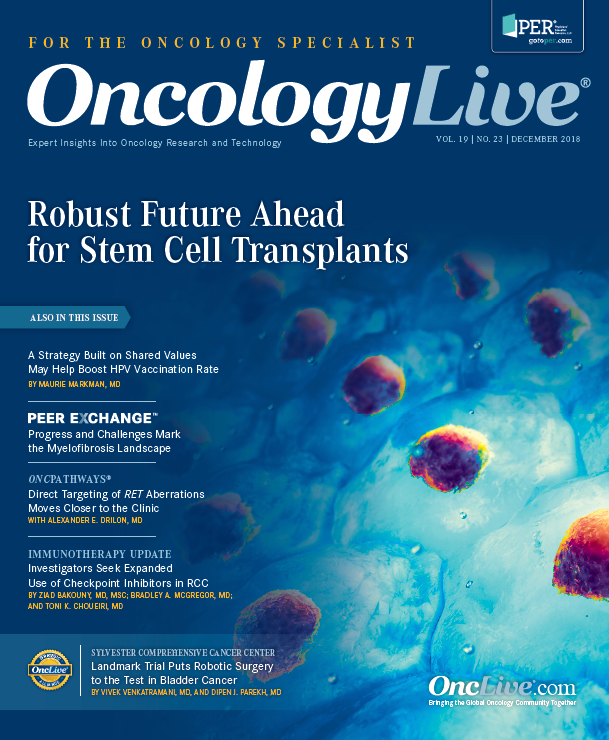Publication
Article
Oncology Live®
An Explorer's Mentality Leads to Novel Treatments in Prostate and Bladder Cancer
Author(s):
Although he held a longtime fascination with space exploration to the moon and Mars, Daniel P. Petrylak, MD, took a different path and broke new ground in another frontier: genitourinary oncology.
Daniel P. Petrylak, MD, professor of Medicine and Urology, co-director, Signal Transduction Research Program, Yale School of Medicine

Daniel P. Petrylak, MD
Although he held a longtime fascination with space exploration to the moon and Mars, Daniel P. Petrylak, MD, took a different path and broke new ground in another frontier: genitourinary oncology. A job in a lab while he was still in his teens launched a career aimed at improving treatments for patients with bladder and prostate cancers.
Petrylak, now 59, grew up in Queens, New York—mostly in Whitestone—and is a self-professed New Yorker through and through. His parents wholeheartedly supported his and his brother’s endeavors, stressing education most of all. “They sacrificed an awful lot, and I am forever indebted to what they did for us. Education, doing well, and exceeding was the most important thing [to them],” Petrylak says.
Although he was always interested in science and was particularly drawn to space science in the 1960s, Petrylak chose to apply his scientific mind to research in medicine. “We can better our lives and better ourselves with new discoveries and trying to use knowledge to help patients or to help society overall,” he says.
Influential Mentors
Today, Petrylak continues to put that philosophy into action as a professor of medicine (medical oncology) and urology and as co-director of the Signal Transduction Research Program at Yale Cancer Center in New Haven, Connecticut.Petrylak's career began early. At just 16, he started working in a laboratory in New York under protozoologist Seymour Hutner, PhD. He was “a very interesting character,” Petrylak says, and taught him much more than science; he covered literature and music in his mentorship, as well.
Hutner himself had an interesting mentor who also indirectly influenced Petrylak: James B. Sumner, PhD, the first to crystallize the jack-bean urease enzyme. In 1946, Sumner won the Nobel Prize in Chemistry for his work in crystallizing enzymes, proving that enzymes are proteins.
Under Hutner’s guidance, Petrylak learned that any research or knowledge you gain doesn’t mean anything unless you can apply it to people. Internalizing this message, Petrylak decided to go to medical school, completing his bachelor of arts degree at Columbia College and his medical degree at Case Western Reserve University School of Medicine. He ultimately chose to specialize in oncology because of the research aspect and its promise of new discoveries to help patients. “Years ago, oncology was almost like voodoo magic; there weren’t great treatments and patients died,” he explains. “So, what better field to explore, especially one in which you can apply your scientific knowledge, to try and improve treatments?”
After graduating from medical school, Petrylak embarked on a 3-year fellowship at Memorial Sloan Kettering Cancer Center (MSK) alongside Howard I. Scher, MD. At the time, Scher was focused on using biology to improve treatments, which taught Petrylak a lot about how to approach novel methods of treating patients. Then, in 1991, Petrylak moved to Columbia University as an assistant professor of medicine and had the good fortune to work with Alan Yagoda, MD. Yagoda had trained several preeminent genitourinary oncologists, including Scher; Cora N. Sternberg, MD; and Dean F. Bajorin, MD. While at MSK in the 1980s, Yagoda, along with Scher and Sternberg, developed MVAC (methotrexate, vinblastine, Adriamycin, and cisplatin) chemo-therapy for patients with bladder cancer. “It was an incredible experience working with [Yagoda]. He could generate numerous ideas; just sitting and talking with him was an unbe-lievable experience,” Petrylak says.
For a week during his fellowship at MSK, Petrylak joined Yagoda for rounds. At Columbia, Yagoda provided guidance for Petrylak’s career, encouraging him to work on clinical trials, give lectures, and put his name out in the academic sphere so that people would become familiar with him. He often repeated this advice: “Work on prostate cancer; nobody’s working on it.”
Accomplishments With Docetaxel
Sadly, Yagoda died suddenly in 1995. “There isn’t a day that goes by that I don’t think about him,” Petrylak says of the man who was a key inspirational force behind his ultimate career choice.During the course of his career, Petrylak has been heavily involved in researching treatments for patients with bladder and prostate cancers. “[For prostate cancer], if you go back to the 1990s, there was nothing that worked for castration-resistant disease. We’ve seen a tremendous amount of progress,” he says.
In 1996, while investigating taxanes’ effects on prostate cancer cells in a laboratory setting, Petrylak discovered that docetaxel (Taxotere) combined with estramustine (Emcyt) demonstrated activity that he and his colleagues wanted to examine further. They designed a phase I trial with the combination, but when they approached the drugs’ manufacturers, the response was, “We have good news and bad news.” The good news was that the companies would happily supply their drugs; the bad news was they would not fund the trial.
So, naturally, the team came up with their own funding and ran their own trial (docetaxel was not yet approved). “I remember, very well, treating the first patient who didn’t respond, and I said to myself, ‘We put all this effort into this and look what happened here,’ and then the next 5 or 6 patients responded,” Petrylak recalls.
At the next Southwest Oncology Group (SWOG) meeting, they presented their results and, with support from E. David Crawford, MD, moved forward with a phase III trial, SWOG 9916. The trial accrued patients and was 1 of the studies that led to docetaxel’s approval for treating patients with castration-resistant prostate cancer (CRPC). To this day, docetaxel is a standard-of-care treatment for patients with CRPC in the first-line setting.
That trial taught Petrylak an important lesson that he carries as his philosophy: Never quit, and always remember to stay positive, because you never know what’s around the corner. “If something doesn’t seem to fit, or it doesn’t seem to be working, keep on plug-ging, keep on going at it, because you just don’t know what’s going to happen,” he says. “I’ve seen so many things that looked bleak and dim [but], in the end, turned out well.”
New Approaches in Bladder Cancer
Since then, Petrylak has led other secondary trials for combination treatments with docetaxel, including serving as the principal investigator on the SPARC trial that investigated satraplatin in patients with CRPC. “Unfortunately, that drug did not show a survival benefit, but I think if we did the trial now and selected patients who had DNA repair mutations, I think we would have had a positive trial,” Petrylak says. This trial showed him how the field had evolved to look at more biologically targeted therapies against different markers.Reflecting on his field, Petrylak says that the ability to conduct trials for bladder cancer has greatly improved. “If you talked to someone about doing a bladder cancer trial with a pharmaceutical company 4 or 5 years ago, they would run in the other direction,” he says. Now, many clinical trials are investigating treatments for bladder cancer because researchers have observed the effectiveness of novel agents such as PD-1 and PD-L1 inhibitors.
According to Petrylak, 3 main areas hold the newest developments for treating bladder cancer: checkpoint inhibitors, potential interactions between antiangiogenic agents and chemotherapy, and newer antibody—drug conjugates that are showing activity. He has been involved in the trials for atezolizumab (Tecentriq) and pembrolizumab (Keytruda) as treatments for bladder cancer. He presented data at 2017 European Society for Medical Oncology Congress from the RANGE study, which is investigating ramucirumab (Cyramza) and docetaxel combined, compared with docetaxel alone, in patients who had prior therapy for metastatic bladder cancer.
Future Research
Recently, he and his colleagues have been working with an anti—Nectin-4 antibody and an anti-SLITRK6 antibody, which are linked to chemotherapeutic agents, and are already seeing responses in patients who failed prior checkpoint therapy. He says integrating all these therapies will be a very interesting area, and he looks forward to working in it.What’s ahead for Petrylak? He hopes to continue to develop drugs. “That’s what I have a passion for, that’s what I really enjoy,” he says. “We’ve come a long way in both [bladder and prostate] tumors, and there’s a lot of room for improvement still.”
For prostate cancer, Petrylak sees research and treatment moving toward the era of personalized medicine, particularly with PARP inhibitors showing efficacy in patients with DNA repair mutations. There is also promise in identifying variants of the androgen receptor that may predict whether a patient will respond to the newer generation of hormonal agents. “I think both fields will start using a more personalized approach as we identify markers for each of those tumors,” Petrylak says.
Off the Clock
For bladder cancer, there are several interesting targets, including FGFR3, PTEN/AKT, and HER2. The correlates of immune response remain a work in progress. “I think all of these studies are crucial, especially now since we are cost conscious, and we don’t want to treat patients unnecessarily. I think we have a lot of work to do, but I think the potential is bright,” Petrylak says.Petrylak always keeps busy reviewing data, taking care of patients, setting up translational work, and forming alliances between basic scientists and scientists who may contribute to research that can be translated to the clinical setting. Although he spends most of his time involved in—and often leading—clinical trials, he also teaches formally and gives lectures for several organizations.
When not at work, Petrylak loves spending time with his wife, especially traveling. They also enjoy biking, tennis, and golf. In fact, his wife only recently took up golf and, according to Petrylak, she can already belt the ball nicely. “She has been absolutely supportive of my career, and I wouldn’t be here now if I didn’t have her support,” he says.
























%20(2)%201-Recovered-Recovered-Recovered-Recovered-Recovered-Recovered-Recovered-Recovered-Recovered-Recovered-Recovered-Recovered-Recovered-Recovered-Recovered-Recovered-Recovered.jpg?fit=crop&auto=format)
%20(2)%201-Recovered-Recovered-Recovered-Recovered-Recovered-Recovered-Recovered-Recovered-Recovered-Recovered-Recovered-Recovered-Recovered-Recovered-Recovered-Recovered-Recovered.jpg?fit=crop&auto=format)
